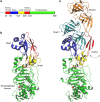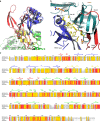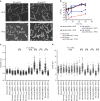Molecular architecture of the PBP2-MreC core bacterial cell wall synthesis complex
- PMID: 28974686
- PMCID: PMC5626683
- DOI: 10.1038/s41467-017-00783-2
Molecular architecture of the PBP2-MreC core bacterial cell wall synthesis complex
Abstract
Bacterial cell wall biosynthesis is an essential process that requires the coordinated activity of peptidoglycan biosynthesis enzymes within multi-protein complexes involved in cell division (the "divisome") and lateral wall growth (the "elongasome"). MreC is a structural protein that serves as a platform during wall elongation, scaffolding other essential peptidoglycan biosynthesis macromolecules, such as penicillin-binding proteins. Despite the importance of these multi-partite complexes, details of their architecture have remained elusive due to the transitory nature of their interactions. Here, we present the crystal structures of the soluble PBP2:MreC core elongasome complex from Helicobacter pylori, and of uncomplexed PBP2. PBP2 recognizes the two-winged MreC molecule upon opening of its N-terminal region, revealing a hydrophobic zipper that serves as binding platform. The PBP2:MreC interface is essential both for protein recognition in vitro and maintenance of bacterial shape and growth. This work allows visualization as to how peptidoglycan machinery proteins are scaffolded, revealing interaction regions that could be targeted by tailored inhibitors.Bacterial wall biosynthesis is a complex process that requires the coordination of multiple enzymes. Here, the authors structurally characterize the PBP2:MreC complex involved in peptidoglycan elongation and cross-linking, and demonstrate that its disruption leads to loss of H. pylori shape and inability to sustain growth.
Conflict of interest statement
The authors declare no competing financial interests.
Figures





Similar articles
-
Characterization of the elongasome core PBP2 : MreC complex of Helicobacter pylori.Mol Microbiol. 2011 Oct;82(1):68-86. doi: 10.1111/j.1365-2958.2011.07791.x. Epub 2011 Sep 15. Mol Microbiol. 2011. PMID: 21801243
-
MreC and MreD balance the interaction between the elongasome proteins PBP2 and RodA.PLoS Genet. 2020 Dec 28;16(12):e1009276. doi: 10.1371/journal.pgen.1009276. eCollection 2020 Dec. PLoS Genet. 2020. PMID: 33370261 Free PMC article.
-
Calcium-dependent complex formation between PBP2 and lytic transglycosylase SltB1 of Pseudomonas aeruginosa.Microb Drug Resist. 2012 Jun;18(3):298-305. doi: 10.1089/mdr.2012.0006. Epub 2012 Mar 20. Microb Drug Resist. 2012. PMID: 22432706
-
Penicillin-Binding Proteins (PBPs) and Bacterial Cell Wall Elongation Complexes.Subcell Biochem. 2019;93:273-289. doi: 10.1007/978-3-030-28151-9_8. Subcell Biochem. 2019. PMID: 31939154 Review.
-
Cell shape determination in Escherichia coli.Curr Opin Microbiol. 2007 Dec;10(6):606-10. doi: 10.1016/j.mib.2007.09.004. Epub 2007 Nov 5. Curr Opin Microbiol. 2007. PMID: 17981077 Review.
Cited by
-
CroR Regulates Expression of pbp4(5) to Promote Cephalosporin Resistance in Enterococcus faecalis.mBio. 2022 Aug 30;13(4):e0111922. doi: 10.1128/mbio.01119-22. Epub 2022 Aug 1. mBio. 2022. PMID: 35913163 Free PMC article.
-
Identification of the potential active site of the septal peptidoglycan polymerase FtsW.PLoS Genet. 2022 Jan 5;18(1):e1009993. doi: 10.1371/journal.pgen.1009993. eCollection 2022 Jan. PLoS Genet. 2022. PMID: 34986161 Free PMC article.
-
Penicillin-binding protein (PBP) inhibitor development: A 10-year chemical perspective.Exp Biol Med (Maywood). 2023 Oct;248(19):1657-1670. doi: 10.1177/15353702231208407. Epub 2023 Nov 29. Exp Biol Med (Maywood). 2023. PMID: 38030964 Free PMC article. Review.
-
Structural basis of peptidoglycan synthesis by E. coli RodA-PBP2 complex.Nat Commun. 2023 Aug 24;14(1):5151. doi: 10.1038/s41467-023-40483-8. Nat Commun. 2023. PMID: 37620344 Free PMC article.
-
A conserved zinc-binding site in Acinetobacter baumannii PBP2 required for elongasome-directed bacterial cell shape.Proc Natl Acad Sci U S A. 2023 Feb 21;120(8):e2215237120. doi: 10.1073/pnas.2215237120. Epub 2023 Feb 14. Proc Natl Acad Sci U S A. 2023. PMID: 36787358 Free PMC article.
References
Publication types
MeSH terms
Substances
Grants and funding
LinkOut - more resources
Full Text Sources
Other Literature Sources

